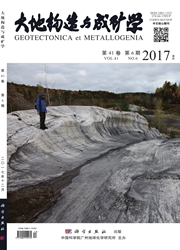

 中文摘要:
中文摘要:
对江西金滩和湖南白马山印支期花岗岩体高精度的LA-ICPMS锆石U-Pb年代学研究表明:金滩黑云母二长花岗岩体给出了(222.1±1.6)Ma的谐和年龄,属印支中晚期,而不是以往所认为的形成于海西期;白马山印支期的黑云母二长花岗岩和黑云母花岗闪长岩分别给出了(223.3±1.4)Ma、(204.5±2.2)Ma的谐和年龄。融合其他年代学数据,湖南白马山印支期花岗质岩浆可能经历了三期侵入活动:其中第一次侵入在印支早期(240Ma左右),其后又经历了220Ma左右和204Ma的另外两幕侵入活动。结合其他相关研究资料进一步表明220Ma左右华南内陆地区可能存在一次广泛的构造-岩浆活动。
 英文摘要:
英文摘要:
The Indosinian tectonic setting of the South China Block is long-debated due to poor understanding of precise geochronology of the associated magmatism. Our studies of highly precise LA-ICPMS zircon U-Pb geochronology on Indosinian granitic plutons in the Baimashan (Hunan) and Jintan areas(Jiangxi) show that the biotite monzonitic granite from the Jintan area yielded a weighted mean ^206Pb/^238U age of (222.1±1.6)Ma,and biotite monzonitic granite and biotite granodiorite from the Baimashan area yielded the concordant ages of (223.3±1.4)Ma and (204.5±2.2)Ma,respectively. These ages represent the formation age of the granitic plutons. In conjunction with other geochronological data,it is inferred that there may be three-episode magma activities for Hunan Baimashan intrusion during the Indosinian involving the first intrusion at about 240Ma,and subsequent intrusion activities of 220Ma and 204Ma,respectively. It is additionally showed an extensive tectono-magmatic activity at about 220Ma for the hinterland of the South China Block.
 同期刊论文项目
同期刊论文项目
 同项目期刊论文
同项目期刊论文
 Tectonic setting of the South China Block in the early Paleozoic: Resolving intracontinental and oce
Tectonic setting of the South China Block in the early Paleozoic: Resolving intracontinental and oce Generation of Early Indosinian enriched mantle-derived granitoid pluton in the Sanjiang Orogen (SW C
Generation of Early Indosinian enriched mantle-derived granitoid pluton in the Sanjiang Orogen (SW C Origin of paleosubduction-modified mantle for Silurian gabbro in the Cathaysia Block: Geochronologic
Origin of paleosubduction-modified mantle for Silurian gabbro in the Cathaysia Block: Geochronologic Phanerozoic tectonics of the South China Block: Key observations and controversies. Gondwana Researc
Phanerozoic tectonics of the South China Block: Key observations and controversies. Gondwana Researc Geochronological and geochemical constraints on the metasomatised source for the Neoproterozoic (~82
Geochronological and geochemical constraints on the metasomatised source for the Neoproterozoic (~82 Zircon U-Pb geochronology of gneissic rocks in the Yunkai massif and its implications on the Caledon
Zircon U-Pb geochronology of gneissic rocks in the Yunkai massif and its implications on the Caledon Indosinian high-strain deformation for the Yunkaidashan tectonic belt, south China: Kinematics and 4
Indosinian high-strain deformation for the Yunkaidashan tectonic belt, south China: Kinematics and 4 Contrasting rift and subduction-related plagiogranites in the Jinshajiang ophiolitic melange, southw
Contrasting rift and subduction-related plagiogranites in the Jinshajiang ophiolitic melange, southw Geochronological and geochemical constraints on petrogenesis of the Middle Paleozoic (Kwangsian) mas
Geochronological and geochemical constraints on petrogenesis of the Middle Paleozoic (Kwangsian) mas Zircon U-Pb geochronological and geochemical constraints on the petrogenesis of the Taishan sanukito
Zircon U-Pb geochronological and geochemical constraints on the petrogenesis of the Taishan sanukito Kwangsian crustal anatexis within the eastern South China Block: Geochemical, zircon U-Pb geochronol
Kwangsian crustal anatexis within the eastern South China Block: Geochemical, zircon U-Pb geochronol Petrogenesis of late Triassic post-collisional basaltic rocks of the Lancangjiang tectonic zone, sou
Petrogenesis of late Triassic post-collisional basaltic rocks of the Lancangjiang tectonic zone, sou 期刊信息
期刊信息
